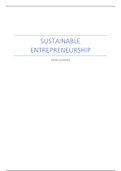Samenvatting
Sustainable Entrepreneurship Article Summary
- Instelling
- Tilburg University (UVT)
The articles included in this summary are: 1. (Bocken, Short, Rana & Evans, 2014) A literature and practice review to develop sustainable business model (SBM) archetypes 2. (Hocksterst & Wuestenhagen, 2010) Greening Goliath vs. emerging Davids – theorizing about the role of incumbents and new e...
[Meer zien]




